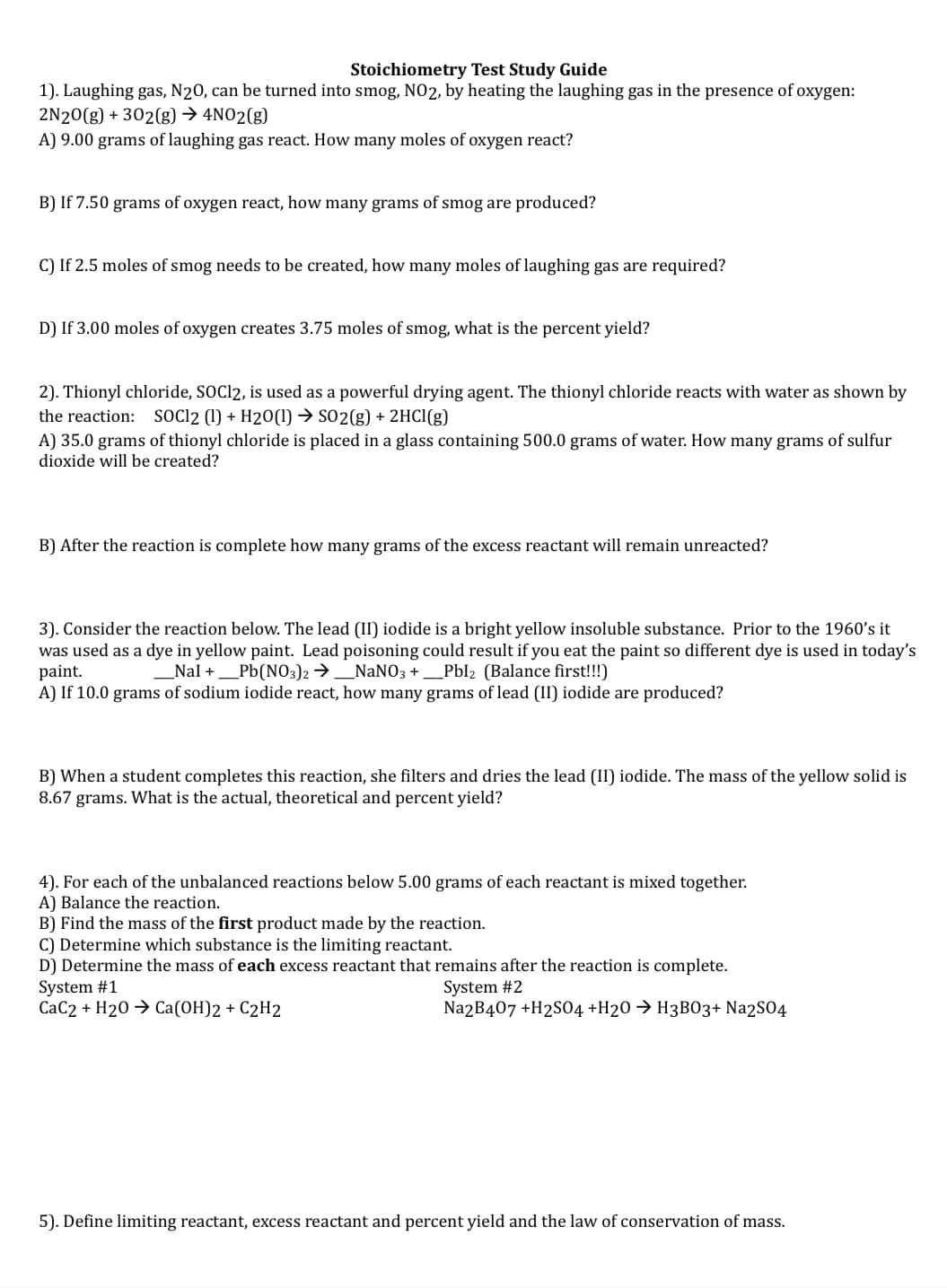4). For each of the unbalanced reactions below 5.00 grams of each reactant is mixed together. A) Balance the reaction. B) Find the mass of the first product made by the reaction. C) Determine which substance is the limiting reactant. D) Determine the mass of each excess reactant that remains after the reaction is complete. System #1 CaC2 + H20 → Ca(OH)2 + C2H2 System #2 NazB407 +H2SO4 +H20 → H3B03+ Na2S04
4). For each of the unbalanced reactions below 5.00 grams of each reactant is mixed together. A) Balance the reaction. B) Find the mass of the first product made by the reaction. C) Determine which substance is the limiting reactant. D) Determine the mass of each excess reactant that remains after the reaction is complete. System #1 CaC2 + H20 → Ca(OH)2 + C2H2 System #2 NazB407 +H2SO4 +H20 → H3B03+ Na2S04
World of Chemistry, 3rd edition
3rd Edition
ISBN:9781133109655
Author:Steven S. Zumdahl, Susan L. Zumdahl, Donald J. DeCoste
Publisher:Steven S. Zumdahl, Susan L. Zumdahl, Donald J. DeCoste
Chapter9: Chemical Quantities
Section: Chapter Questions
Problem 71A
Related questions
Question
#4 pl

Transcribed Image Text:Stoichiometry Test Study Guide
1). Laughing gas, N20, can be turned into smog, NO2, by heating the laughing gas in the presence of oxygen:
2N20(g) + 302(g) → 4NO2(g)
A) 9.00 grams of laughing gas react. How many moles of oxygen react?
B) If 7.50 grams of oxygen react, how many grams of smog are produced?
C) If 2.5 moles of smog needs to be created, how many moles of laughing gas are required?
D) If 3.00 moles of oxygen creates 3.75 moles of smog, what is the percent yield?
2). Thionyl chloride, SOC12, is used as a powerful drying agent. The thionyl chloride reacts with water as shown by
the reaction: SOCI2 (1) + H20(1) → SO2(g) + 2HCI(g)
A) 35.0 grams of thionyl chloride is placed in a glass containing 500.0 grams of water. How many grams of sulfur
dioxide will be created?
B) After the reaction is complete how many grams of the excess reactant will remain unreacted?
3). Consider the reaction below. The lead (II) iodide is a bright yellow insoluble substance. Prior to the 1960's it
was used as a dye in yellow paint. Lead poisoning could result if you eat the paint so different dye is used in today's
paint.
A) If 10.0 grams of sodium iodide react, how many grams of lead (II) iodide are produced?
_Nal +_Pb(NO3)2 →_NaNO3 +_Pbl2 (Balance first!!!)
B) When a student completes this reaction, she filters and dries the lead (II) iodide. The mass of the yellow solid is
8.67 grams. What is the actual, theoretical and percent yield?
4). For each of the unbalanced reactions below 5.00 grams of each reactant is mixed together.
A) Balance the reaction.
B) Find the mass of the first product made by the reaction.
C) Determine which substance is the limiting reactant.
D) Determine the mass of each excess reactant that remains after the reaction is complete.
System #1
CaC2 + H20 → Ca(OH)2 + C2H2
System #2
Na2B407 +H2SO4 +H20 → H3B03+ Na2S04
5). Define limiting reactant, excess reactant and percent yield and the law of conservation of mass.
Expert Solution
This question has been solved!
Explore an expertly crafted, step-by-step solution for a thorough understanding of key concepts.
This is a popular solution!
Trending now
This is a popular solution!
Step by step
Solved in 5 steps

Knowledge Booster
Learn more about
Need a deep-dive on the concept behind this application? Look no further. Learn more about this topic, chemistry and related others by exploring similar questions and additional content below.Recommended textbooks for you

World of Chemistry, 3rd edition
Chemistry
ISBN:
9781133109655
Author:
Steven S. Zumdahl, Susan L. Zumdahl, Donald J. DeCoste
Publisher:
Brooks / Cole / Cengage Learning

Chemistry: Matter and Change
Chemistry
ISBN:
9780078746376
Author:
Dinah Zike, Laurel Dingrando, Nicholas Hainen, Cheryl Wistrom
Publisher:
Glencoe/McGraw-Hill School Pub Co

Chemistry: Principles and Reactions
Chemistry
ISBN:
9781305079373
Author:
William L. Masterton, Cecile N. Hurley
Publisher:
Cengage Learning

World of Chemistry, 3rd edition
Chemistry
ISBN:
9781133109655
Author:
Steven S. Zumdahl, Susan L. Zumdahl, Donald J. DeCoste
Publisher:
Brooks / Cole / Cengage Learning

Chemistry: Matter and Change
Chemistry
ISBN:
9780078746376
Author:
Dinah Zike, Laurel Dingrando, Nicholas Hainen, Cheryl Wistrom
Publisher:
Glencoe/McGraw-Hill School Pub Co

Chemistry: Principles and Reactions
Chemistry
ISBN:
9781305079373
Author:
William L. Masterton, Cecile N. Hurley
Publisher:
Cengage Learning

Introductory Chemistry: A Foundation
Chemistry
ISBN:
9781337399425
Author:
Steven S. Zumdahl, Donald J. DeCoste
Publisher:
Cengage Learning

World of Chemistry
Chemistry
ISBN:
9780618562763
Author:
Steven S. Zumdahl
Publisher:
Houghton Mifflin College Div

Chemistry for Engineering Students
Chemistry
ISBN:
9781337398909
Author:
Lawrence S. Brown, Tom Holme
Publisher:
Cengage Learning